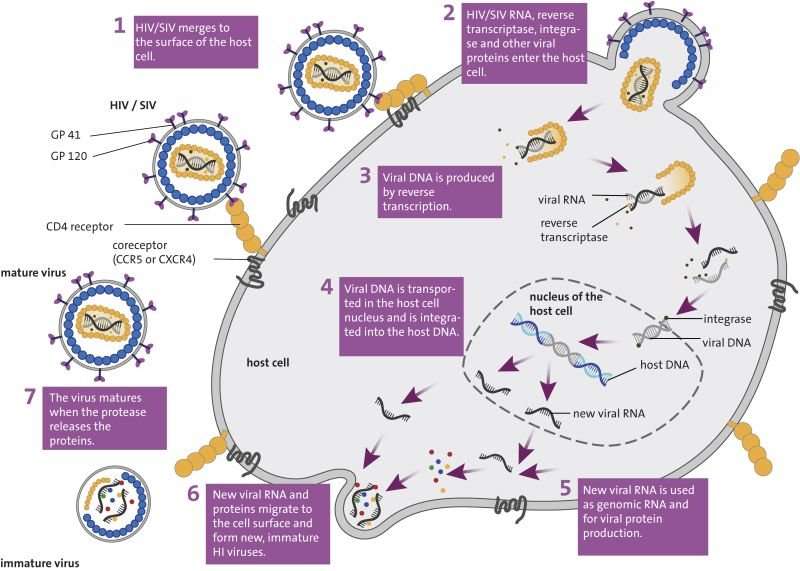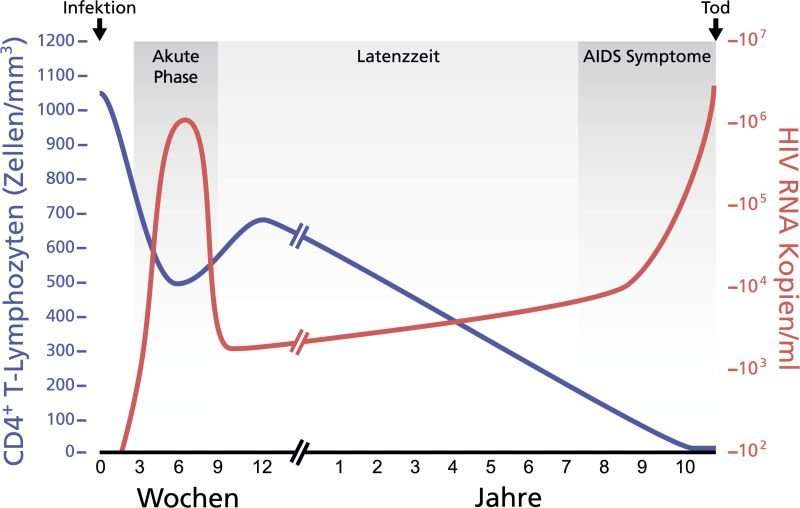Developing a new vaccination strategy against AIDS

According to the WHO, there are currently more than 36 million people infected with the human immunodeficiency virus (HIV) and a further 2.4 million become infected every year. Despite treatment success against the virus, it is important to find a vaccine. Infection researchers from the German Primate Center (DPZ) - Leibniz Institute for Primate Research have in cooperation with international colleagues tested a new, two-component vaccination strategy against the HIV-related simian immunodeficiency virus (SIV) in rhesus monkeys.
The monkeys were immunized subcutaneously, orally and intramuscularly with a time delay and in alternating order. The scientists were able to show that the type of booster vaccine, orally and intramuscularly, as well as the order of the vaccine components, influenced the activation of the immune system. These represent vital factors in the long-term prevention of a SIV infection. Since SIV and HIV mainly replicate in the body's own activated CD4+ T helper cells that are critical for the immune defense, it is crucial that their level remains relatively low, even after vaccination. In order to achieve sustained protective immunity against AIDS, a vaccination strategy inducing a balanced immune response without an increase of CD4+ T helper cells must be developed (Journal of Virology).
There are many reasons for the lack of a vaccine against HIV infection. In contrast to conventional vaccines, the (active) agent against HIV must trigger an immune response strong enough to make sure that no single cell will be infected; otherwise, the virus will be permanently integrated into the genome of the cells. This is not necessary with other vaccines, since most viruses are not firmly anchored to the genome. Thus, researchers seek a vaccine response more rapid than the spread of the virus and one that can stop damage to the cells.
Another hurdle for a vaccine against AIDS is the immune system itself. CD4+ T helper cells are needed in order for the body's immune system to trigger an optimal immune response. The dilemma for vaccine research is that these cells are also the target cells for an infection with HIV or SIV. The international research partners have tested a vaccination approach that takes these critical factors into account.
The researchers administered a potential vaccine consisting of two components to 12 rhesus monkeys that served as an animal model for human HIV infection. The administration of a compound vaccine is referred to as a prime-boost vaccination. In the initial step, all monkeys were treated with genetically modified SIV, which infected the host cells but was unable to replicate in the body. This procedure serves as an "initial stimulant" of the immune system (priming). The monkeys were then divided into two groups, where they then received the second vaccination component consisting of two different viral vectors via different routes.

The non-pathogenic vectors serve as gene shuttles to transport components of SIV, such as envelope proteins, into the target cells. This second step increases the immune response (boost). In the first step, six monkeys received an adenovirus gene shuttle, which was administered orally as a spray. In the second step they received an intramuscular injection with a gene shuttle from the fowlpox virus. For the other six monkeys, the scientists reversed the process. In this group, first the fowlpox vector was administered orally, followed by the adenovirus vector as an injection. Following this, the monkeys had weekly intervals of exposure to low doses of SIV, which triggers an AIDS-like disease. This process continued until almost all the monkeys were infected.
"We observed that the virus in all vaccinated animals initially replicated less than in the control group," Ulrike Sauermann, first author of the study, summarized the results. "This shows that the vaccine induced a protective response in the immunized monkeys. In the second group that was first treated with the fowlpox vector and afterwards with the adenovirus vector, the likelihood of an infection was reduced by about 70 percent, compared to only a 12 percent reduction in the first group. In addition, the CD4+ T helper cells were less activated in the second group. "
The data show that the order and type of administration (oral spray or injection) of the vaccines may affect the activation of the immune system and may have a long-lasting effect that influences subsequent immunizations as well as the susceptibility to infection. It is therefore important to find a balance between the T helper cell response and the remaining immune responses. An excessive activation of CD4+ T helper cells can otherwise reverse the protective immune response.
"Results from a former AIDS vaccine study have shown that in a worst case scenario, immunization against HIV could enhance infection," says Christiane Stahl-Hennig, who designed the project in cooperation with the former DPZ employee Sieghart Sopper.
"Even though a comparable monkey vaccination strategy previously failed, the study was nevertheless carried out in humans. In order to identify and avoid possible risks that could arise from vaccination against AIDS, it is essential to carefully plan and execute animal experiments in pre-clinical studies. We do believe that we have found an effective component for a compound vaccine. The immunization with SIV components in a fowlpox vector appears to be safe and promising. In the follow-up experiments, our aim is the further improvement of the booster immunization in order to achieve an even higher efficiency and protection rate."
More information: Ulrike Sauermann et al, Vector Order Determines Protection against Pathogenic Simian Immunodeficiency Virus Infection in a Triple-Component Vaccine by Balancing CD4+and CD8+T-Cell Responses, Journal of Virology (2017). DOI: 10.1128/JVI.01120-17


















